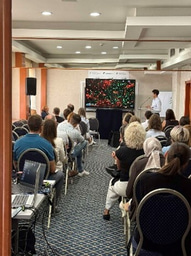Why storytelling should be part of your professional toolkit

Try something for me. If you have access to a generative AI tool like Chat GPT or Claude, ask it to provide you with a list of 100 words commonly associated with research.
Have a go…
What did it say? Did it mention storytelling? I’m willing to bet in most cases, that word wouldn’t appear.
Now go back to your AI assistant and ask it what skills a good researcher needs.
Every time I’ve tried this there is usually mention of the importance of communication. Here’s what Chat GPT said when I asked:
Communication Skills: The ability to express ideas clearly, both in writing and verbally, is crucial for presenting research findings and collaborating with others.
I want to make the argument that storytelling and narrative understanding, despite not being something that people might traditionally associate with research, should be an important part of your skillset. Here’s why…
Why are stories important?
As Will Storr, and just about every other author writing on the topic, sets out in the Science of Storytelling, we’re all storytellers. It’s an innate part of how we communicate with others about the world and our place in it. Some argue there’s an evolutionary, survival purpose as well.
It’s not hard to do. If you start something with the word “Once,…” or “I remember this time when…” you’re in story mode.
Stories help us make sense of the world. They help us remember important information. They entertain people and give them a reason to come together.
When it comes to research, one area where I think this matters is in public engagement.
Stories for public engagement
All research happens in a societal context. Its function is to enable us to better understand or improve something about the world, so there are many stakeholders, even with the most seemingly rarefied of topics. Part of the role of the researcher is to reach out to people and communities affected by the work.
Much of the communication involved in research (theses, reports, analysis, etc.) is technical and abstract, and there’s good reason for that. A lot of what you are trying to do is to transfer knowledge into someone else’s head in a way that’s as accurate and unambiguous as possible.
Unfortunately, that makes it impenetrable for most people outside of your specialism, which is a problem if you are trying to engage other groups. This is where storytelling comes in.
Telling stories about research
A few years ago, I was invited to run some workshops at Strathclyde University on digital storytelling for researchers. They wanted to augment their successful Images of Research outreach exhibition with multi-media stories that got deeper under the surface of the work and their researchers’ motivations.
You can see those examples that have been created over the years on their YouTube channel. To differing degrees, these people have employed storytelling techniques to communicate their work to a wide audience.
Loughborough University’s Storytelling Academy has other examples and I like this one from Sweden from a few years ago about research into the physiology of pain. (Content: includes general descriptions of animal testing).
The reason I think this works is that alongside the simple explanation of the work, we get a clear idea of why this is important to Camilla Svensson through the story she has told us about it. It gives us a way in.
How to tell your own story
What’s the point?
Finding a story to tell in the complexity of your work will sometimes be tricky. It’s always worth starting with the end in mind. You are trying to get attention and you’re trying to get a reaction. This might lead to curiosity and the ultimate goal: engagement.
The best place to begin is to ask yourself 2 questions:
- Why does all this matter to me?
- Why should it matter to you?
Even if you don’t spell these out in your finished story, the answers to these questions will keep you focused and give you inspiration.
Writing your story
I’ve distilled the best ideas I’ve come across into this short video. There’s plenty more suggestions out there but I’ve found these are the most impactful.
What tools to use
Digital storytelling is simply about using digital tools to convey your story. Exactly how you do that is up to you. You might be thinking of making a video, but a blog post or social media update can work just as well. I’ve even seen people use mapping tools like Google Earth to do it.
Ideally you want to find tools that are simple to use so that you can focus on the story and not get bogged down in the technicalities of production.
Adobe’s Express suite of tools is one of my current favourites and the one we use in our workshops. It’s well featured and currently doesn’t require a subscription (although paying a bit gives access to more capabilities)
Some things to bear in mind
Storytelling works best as a social endeavour – I always recommend finding ways of working on your stories with other people before you get round to producing them in digital formats. It helps give you a better feel for what people will respond to.
Stories don’t have to be about things going well – it’s not always a comfortable experience talking about the hurdles, slip-ups and outright failures but there can be useful lessons to communicate this way and are often the best way of starting honest conversations about what it actually means to be a researcher.
Is a story reliable? It depends on what you mean. Stories aren’t an objective truth. They’re filtered through experiences and emotions and even your audience may disagree about what different things mean. It’s important not to treat them as an alternative to more rigorous forms of communication and always think about the ethical dimension of your role as storyteller.
The main thing
For me, the main point of being a storytelling researcher is that it puts humans at the heart of the work. People like to hear about other people and that gives us a powerful route to sharing what’s most meaningful about what we’re trying to achieve.
It gives you the opportunity to be creative and think in new ways. It also allows for some surprising outcomes. One comment that sticks with me from those Strathclyde Workshops was a researcher from a scientific field saying that telling stories about their work actually made them think about it in ways they hadn’t considered before; it changed their whole perspective.
So, how would you tell your research story?
Photo by Katherine Hanlon on Unsplash





Join the FEBS Network today
Joining the FEBS Network’s molecular life sciences community enables you to access special content on the site, present your profile, 'follow' contributors, 'comment' on and 'like' content, post your own content, and set up a tailored email digest for updates.